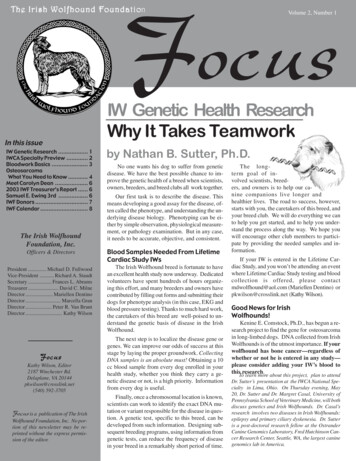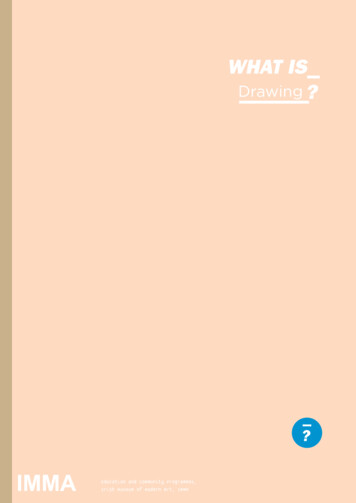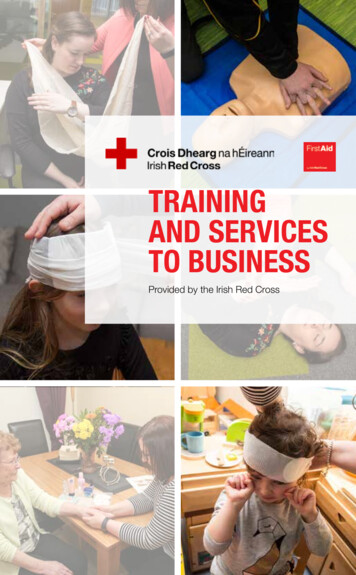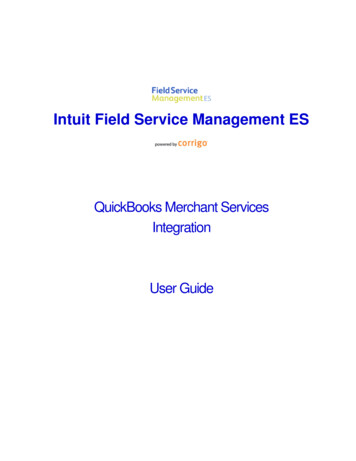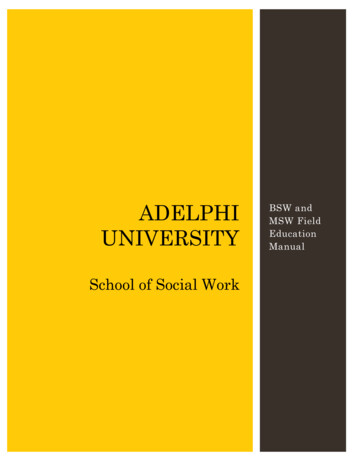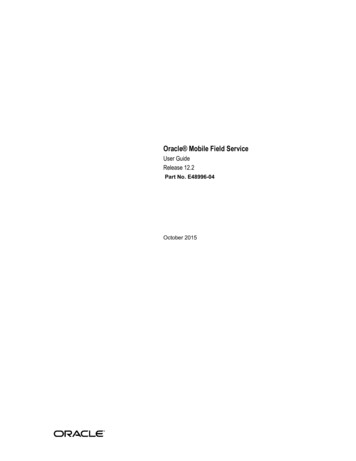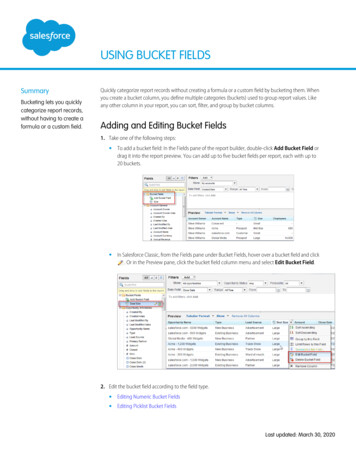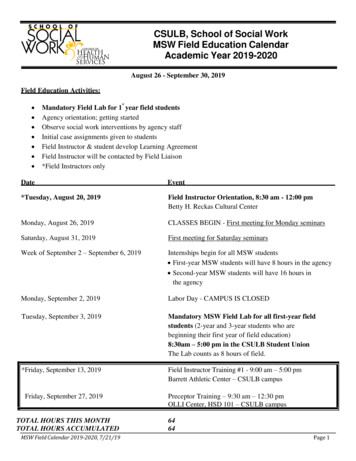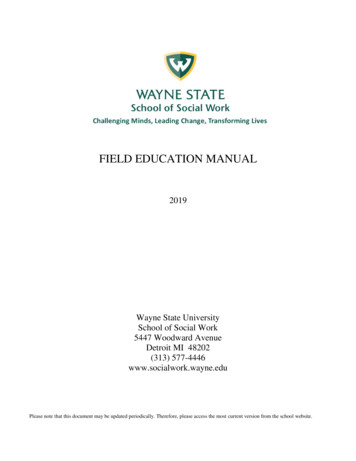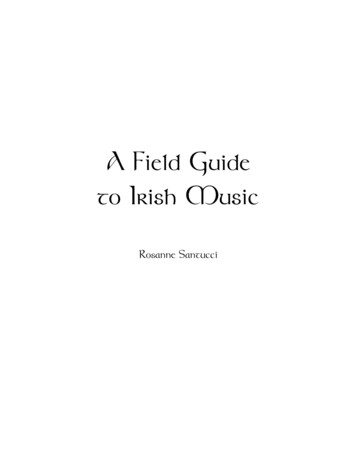
Transcription
A Field Guideto Irish MusicRosanne Santucci
Table of ContentsTable of Contents . 2About Irish Music . 3Guitar Chords . 7Where to Listen . 8Where to Learn . 10Tunes . 11About This BookI wrote this out of sympathy for anyone who’s interested in playing Irish traditionalmusic but has no idea where or how to start; in other words, someone like me as ofa few years ago. I didn’t know what a session was like, and I didn’t understand whytunes sounded painfully lame when I played them verbatim off the page. One lazysummer day, I Googled “Boston Irish session” and found out about the early sessionat the Green Briar in Brighton. After mustering up my courage, I showed up and satthere, ears open and flute in my lap, every week for months until the tunes started tosink in and I saw what other players did to breathe life into them. Gradually Ibranched out to other sessions, picking up a few instruments along the way andlearning a ton from the many fine musicians I have encountered.This book is my way of “passing it forward” — I’ve tried to compile the tips I’vefound most useful while throwing in some great tunes commonly heard aroundtown. Copies are available online at:http://web.mit.edu/ santucci/www/tunes/tunes.pdf(Free to all, just don’t sell it or pass it off as your own.) Second edition, 2018,Rosanne Santucci2
About Irish MusicIrish traditional music is part of the genre labelled “Celtic” — the folk music of Ireland,Scotland, Brittany (France), Galicia (Spain) and the Maritime provinces of Canada. It is avibrant, living tradition that is both popular in its own right and influential on rock,punk, and other styles.Irish traditional music falls into two broad categories: songs and tunes (mostly dancemusic), the latter of which is the focus of this book. The characteristic sound of an Irishtune comes from a combination of: Instruments: fiddle, flute, whistle, uilleann pipes, accordion, concertina, harp,bodhrán (hand drum), guitar, bouzouki Rhythms: jigs, reels, etc.; mostly quarter and eighth notes, not very complex Melody: often modal, usually not more than 1 1/2 octave span, not manyaccidentals. Everyone generally plays the tune in unison. Harmony: minimal; some melody instruments might add an occasional chord(e.g. double-stops on the fiddle). Guitar/bouzouki/piano backing is light andoften open chords (leaving out the third, so it fits with major or minor). Ornamentation: the “twiddly bits” around the notes Phrasing: often slurs into the next bar Variation: the skeleton of the tune is always there, but slight variation is verycommon; phrases are often not played the same way twiceCommon dance rhythmsReels: 4/4, cut time (“in 2”). Eighth notes can be swingy, straight, or somewhere in themiddle depending on who you're playing with.Hornpipes: 4/4, cut time, slower than a reel and with a swing feel in the eighth notes(DAH-dee-DAH-dee). More triplets (DEE-dle-dee) than you'd find in a reel.Jigs: 6/8, in 2. The beat is typically the same tempo as a reel (jig dotted quarter reelhalf note).Slip Jigs: A jig with an extra beat in it. 9/8, in 3.Slides: Faster than a jig, with fewer notes and longer phrases. 12/8 (in 4).Hop Jigs: A slide with 3 beats. These can sound a lot like slip jigs if played slowly.Polkas: 2/4, in 2. Moderately to very fast.3
ScalesTunes most commonly have one or two sharps in the key signatures, probably due tothe limitations of keyless flutes and whistles. Within these key signatures are a host ofavailable major, minor, and modal scales: One sharp: G major, E minor, A dorian (A minor with an F sharp), D mixolydian(D major with a C natural) Two sharps: D major, B minor, E dorian, A mixolydianYou will also occasionally hear tunes with no sharps (C major, D dorian, G mixolydian)and three sharps (A major, F# minor).Notes for Classical PlayersComing from a classical background, here are the differences I have found mostsignificant when playing Irish music:ClassicalIrishlearning musicusually learn by readingmusicusually learn by earperforming musicread music, except whenplaying soloalways play from memorysoundsmooth, even, “pretty” —lots of time is spentperfecting one’s tonecan be more aggressive —lots of breath/bowaccents, OK to really pushitvibratovibrato essentialcharacteristic of sound onmost wind/stringinstrumentslittle to no vibrato onfiddle; finger vibrato onwind instruments (rapidtapping of finger on openhole without significantlychanging pitch of note)articulationvaries, depending oncomposer and time periodslur into downbeat;phrases often go acrossthe barline4
ClassicalIrishgrace noteson or before the beat, fastor slow depending oncomposer and time periodusually so quick that youdon't hear a pitch; on (orbefore, but very close to)the beatrollsnotes within the turn areusually evencertain notes in the roll areso quick, they’re almostimperceptibleother ornamentstrills, mordentscuts, strikes, double cuts,slides, cranns, occasionallytrillsimprovisationnot unless specifiedfine as long as it maintainsthe basic skeleton of thetune, e.g. eighth-notetriplet F-E-D instead oftwo eighths F-Dtemposome degree of rubato(push and pull) is expecteddepending on thecomposer and time periodrock-steady and drivingahead — keep that flowgoing! Keeping goodrhythm is probably themost important part ofplaying Irish music.OrnamentationOrnamentation in Irish music can be very difficult to learn because it goes by so quicklyit’s hard to hear (and see) what players are doing. Here are the basic ornaments:Cut. A very quick grace note starting from above. The “notes” of the cuts need not befingered as real notes; as long as you lift a finger that produces a pitch higher than thewritten note, that will suffice. Happens almost simultaneously with the written note;sounds more percussive than pitched.Strike (also called a tip, tap, or pat). Just like the cut, but it starts from below.5
Long roll. The length of three eighth notes. Start on the written note, cut it, and strikeit. Flute players often place the cut and strike on the 2nd and 3rd eighth notes, whilefiddle players tend to save the cut and strike for the very end.Short roll. The length of two eighth notes. Cut the written note, then strike it.Crann. The written note, followed by two or three cuts. Very common on pipes, flute,whistle.Slide (upward). A smooth slide achieved by pushing or sliding your finger off a hole orup the fingerboard to the written note from a half- or whole-step below it.The best way to learn is by working with a teacher, but there are some really helpfulbooks out there that come with CDs. For flute and whistle players: An Fheadóg Mhór by Conal Ó Gráda, available from his website,https://www.conalograda.com/store The Essential Guide to Irish Flute and Tin Whistle by Grey Larsen, available onamazon.comAnd for fiddle players, try the Irish Fiddle Book by Matt Cranitch, available onamazon.com.Note: There is no consistent notation for these ornaments; different people usedifferent symbols.6
Guitar ChordsDADGAD tuning is probably the most frequently used tuning for Irish traditional music,though plenty of people use other tunings as well. The advantage of DADGAD is thatthe upper A and D strings provide a "drone" which fits very well with the music, butthe disadvantage is that you need to move your capo more often. I won't go into guitarstrumming patterns for Irish music here, but it's essential to get the right rhythmic feel;listen closely to the guitar backers I've listed on the next page.7
Where to ListenRecordingsJust a few of my personal favorites here. easily found on iTunes, YouTube, or Google.A few of them live locally or pass through frequently.flute: Conal Ó Gráda, Paddy Carty, Louise Mulcahy, Catherine McEvoy, Matt Molloy,Shannon Heaton, Sean Gavinwhistle: Mary Bergin, Joanie Madden, Sean Ryan, Fintan Vallelyfiddle: Tommy Peoples, MacDara Ó Raghallaigh, Denis Murphy, Aidan Connolly, AlisonPerkins, Nathan Gourley, Laura Feddersen, Fergal Scahillguitar/bouzouki: Brian Miller, John Blake, Steve Cooney (with Seamus Begley), PatrickDoocey, Alec Finn, Eoin O'Neill, Donal Lunny, Mick Conneelybodhrán/drum set/spoons: Johnny Ringo McDonagh, Josh Dukes (with The Yanks),Christy Barrybanjo: Pauline Conneely, Quentin Cooper, Angelina Carberryaccordion/melodeon: Billy McComiskey, John Gannon, Jackie Daly, Seamus Begleyconcertina: Caitlín Nic Gabhann, Noel Hill, Mícheál Ó Raghallaighuilleann pipes: Willie Clancy, Benedict Koehler, Joey Abarta, Cillian Vallely, MickeyDunne, Tiarnán Ó Duinnchinnsingers: Dolores Keane, Brian Ó hAirt (with Bua), Bridget Fitzgeraldbands: NicGaviskey, the Bothy Band, the Press Gang, Dervish, the Yanks, KilfenoraCeili BandNearby Irish Sessions (weekly unless otherwise indicated)Beginner-friendly sessions are marked with a *. Sessions come and go, so it's a goodidea to check with the venue first before venturing out.Sundays: The Burren, 247 Elm St. (Davis Sq.), Somerville, 3-6pmMondays: Green Briar, 304 Washington St., Brighton, intermediate session 7-9pm*, fastsession 9pm-12am; The Burren, 247 Elm St. (Davis Sq.), Somerville, 9pm-midnightTuesdays: The Druid, 1357 Cambridge St. (Inman Sq.), Cambridge, 9pmWednesdays: Emmets Pub, 6 Beacon St, Boston (9pm?)8
Thursdays: Canadian American Club, 202 Arlington St., Watertown, 7-10pm*;Somerville Irish Music Meetup Slow Practice Session, Clarendon Hill PresbyterianChurch, 155 Powder House Blvd (Teele Sq.), Somerville, 7-9pm (meets monthly; seemeetup.com)*Fridays: The Burren, 247 Elm St. (Davis Sq.), Somerville, 9:30pm-1am (a gig, not anopen session, but fun to listen to)Saturdays: Brendan Behan Pub, 378 Centre St., Jamaica Plain, 5-8pm; The Druid, 1357Cambridge St. (Inman Sq.), Cambridge, 4pm; Emmets Pub, 6 Beacon St, Boston (notsure of time)Session EtiquetteNot every session is an open session. Don’t join a group of unfamiliar musicians withoutasking if it's open. If you’re new, let the regulars sit up front.If you don’t know the tune very well, sit back and listen. If you only know parts of it,play only the parts you know. Otherwise, use the time to absorb the tune and silentlywork it out on your instrument. Ask the musicians if they'd mind if you recorded themso that you can learn their tunes for next time — very few will say no!Try to play in tune and make sure you listen to the people around you.Take your cue from the session leaders as to whether/when it's appropriate for you tostart a tune. The leaders pick the tunes in some sessions, while people take turns inothers. If you’d like to start a tune, ask the other musicians if they know it and wouldlike to play it. Otherwise, you might find yourself unexpectedly — and awkwardly —playing solo.If you’ve got a set of two or three tunes you’d like to play, practice the transitions soyou don’t draw a blank when it's time to switch tunes!Generally speaking, only one bodhrán/guitar/bouzouki/whistle at a time.If you're playing a backing instrument, be very sensitive to the melody players. It canbe tough to hear each other in loud pubs, and when you add a guitar or bodhrán it canbe that much harder — plus if you're playing with chords that are too busy or just plainwrong, dragging or rushing, etc., it will be extremely distracting to the other musicians.This music does not require accompaniment, and while it's fun to have a great backer,a poor one can really wreck a session.9
Where to LearnLessonsLocally, the CCÉ Boston Music School (bostonirishmusic.com) offers group lessons forchildren, teens, and adults in Irish traditional music on Saturdays in Brighton. It issponsored by the Reynolds-Hanafin-Cooley Branch of Comhaltas Ceoltoiri Éireann(COAL-tas kyol-TOR-ee AIR-in), an international nonprofit organization dedicated topreserving traditional Irish music, song, dance, language, and culture. They have a firstclass roster of teachers who are professional musicians living in the Boston area, andwho have performed all over the world. They also have instruments available to rent.Online, the Online Academy of Irish Music (oaim.ie) is a wonderful resource and worththe membership fee. There are also many tutorials available on YouTube, of varyingquality.Tune collections, discussion forums, audio, videoAmazing Slow Downer, http://www.ronimusic.com/: a must-have piece of software forlearning by ear.Tunepal, tunepal.org: Available as an app or desktop site. Record a tune into yourmicrophone and it will tell you its name. Pro tip: The old desktop site,http://tunepal.org/tunepal/index.php, is still active; it requires Java and ABC notationinput, but it's more accurate than the regular app.The Session, http://www.thesession.org/: Tune repository and discussion forum for Irishtraditional music.Chiff and Fipple, Chiffandfipple.com: Another discussion form, especially good forplayers of whistle, flute, and uilleann pipes.ABC Notation Home Page, http://www.abcnotation.com/: ABC notation is a text-basedmusic notation system perfectly suited for traditional music. It comes in very handywhen you want to write down how a tune goes, but don’t have any manuscript paperhandy. This site has a tutorial — very easy to learn.ABC Converter, http://www.mandolintab.net/abcconverter.php: Turn your ABCnotation into staff notation that can be saved as PDF.Na Píobairí Uilleann, http://pipers.ie/source/: Lots of great videos, plus piping tutorials.Follow clarebannerman's channel on YouTube or Ciaran Kelly on Facebook — loads ofhistoric video clips.10
TunesReelsSilver SpearDGDG441DDG2EmAEmA3DGDG1DGGBmA2EmAEmA3Rhythm: reelThe Sligo MaidAminG4431AminG2GG3AminAminGGEmin7Amin3Rhythm: reel11
HornpipesHarvest HomeDA443D3DA3A3D33ADRhythm: hornpipeThe Rights Of ManEmAmD44EmBmGEmEmDDGD3EmBmEm3Rhythm: hornpipe12
JigsJohn e Hag’s Purse (a.k.a. Hardiman’s Fancy, Joe Derrane’s)GAD68GAABmin1DDDBminADD2G1 BminD2 Bmin13
Slip JigsRyan’s Slip JigDGDG98DGDGSwaggering JigGD981 CGD2 CDGDGCDGCDGAmin7Amin7GD14
SlidesMerrily Kiss the QuakerGCGDGC1GD2GDG128GDGD1GC Bmin7 Emin7DD1 GGDG2DG2 GDGDenis Murphy’sDGDE- A1 G ADD2 G AD128DGDGDADGD1 GAD2 GAD15
Hop JigsThe ButterflyEmDEmDEmDBm98Am7Am7EmEmAm7DCEmDGDRhythm: slip jigBoys of BallisodareGCGGAmin7C98GCGGGCCGGGCAmin7CDCD16
PolkasBallydesmond #2AmG24AmAmGEm7AmGEm7AmGAmGlen Cottage PolkaA (no 3rd)G24AAADGGAGA17
the disadvantage is that you need to move your capo more often. I won't go into guitar strumming patterns for Irish music here, but it's essential to get the right rhythmic feel; listen closely to the

